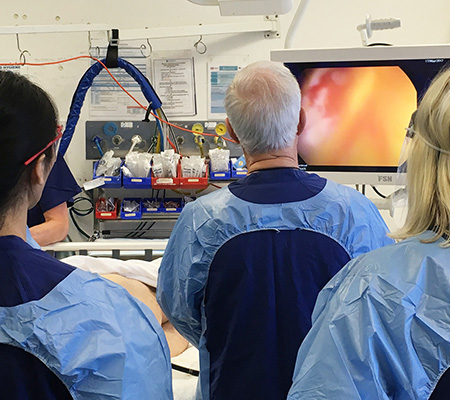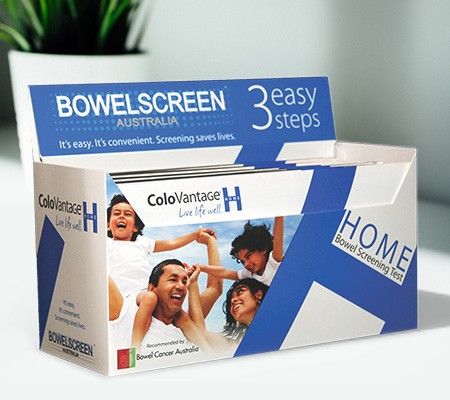After surgery some people can eat normal foods and have normal bowel motions. However, some people experience loose bowel motions or constipation. The low fibre diet is often suggested for people who are experiencing difficult bowel motions and for some people temporarily in inflammatory bowel conditions.
The low fibre diet is often suggested in both diarrhoea and constipation scenarios with a few minor adjustments. Your specialist may also suggest some medication to help reduce the number and quantity of loose motions or medication for constipation.
As your symptoms improve and your bowel motions normalise you may be able to start reintroducing your favourite foods. Do this slowly and add one new food at half a cup at a time so you can identify any foods that cause bowel upset.
If you experience constipation or any sign of blockage – not opening your bowels for two to three days, please contact your specialist or healthcare professional.
If you experience extremely loose watery bowel motions and leakage, pain or fever please contact your specialist or healthcare professional.
Low fibre diets may not be suitable for diabetics. This is due to the low amount of fibre in low fibre foods. Fibre assists blood glucose levels to remain stable and is at the core of a diabetic diet. If you are diabetic and you wish to eat less fibre in your diet due to bowel conditions, please discuss this with your healthcare professional
A lower fibre diet is may be suggested until you start having bowel motions that are mostly formed, not too hard, pass easily and cause not pain or upset, after which you may be able to have larger food particles and some fibre.
Once the initial bowel movement has occurred some people have difficulty with fibre foods for the following reasons:
• Constant loose bowel movements
• Pain or constipation
• Diarrhoea, gas, cramping or digestive upset
If you are losing weight drink some protein drinks in between meals with a milk of your choice.
Lactose intolerance may occur after surgery in some people, a food diary will help you determine this or speak to your health care professional. Lactose is found in dairy products such as milk, cheese, yoghurt and ice cream and some processed and packaged foods.
Make sure you have plenty of water. Aim for 6-8 cups of water a day, if you like some flavour in water enjoy some sliced fruit in water to infuse some healthy sugars.
Multivitamin and mineral supplementation may be necessary. Check with your health care professional.
All foods are better tolerated if they are well cooked, peeled, deseeded or in some cases blended in a food processor. Meat and vegetables and fruits may need to be cooked and consumed in small portion sizes and after surgery for a while. Raw uncooked fruit and vegetables may not be tolerated in the beginning and until your bowel starts to recover.
Avoid whole nuts, coconuts, whole seeds, and large tough pieces of meat, or chicken, whole mushrooms, beans and legumes, wholegrains, popcorn, pomegranate, and fruit with peel, large pips, and celery unless well chopped. All vegetables with stalks need to be well-cooked and blended or avoided.
If you are experiencing very loose bowels add white rice to your meals, or mash potato or flour to firm motions and avoid leakage. Other foods that help are marshmallows, arrow root biscuits, white bread and slightly green bananas to firm the movement. Talk to a health care professional if you are experiencing any soreness internally or externally. There are gentle washes and creams that can be applied externally if there is redness and stinging. Internal soreness may mean you need to talk with your specialist.
If your motions are watery you may need to add Psyllium husk or Metamucil to bind the watery flow. This is a fibre and would need to be introduced slowly to avoid constipation, remembering to increase water intake at the same time.
Once your bowel has settled after a few weeks to months you may at some stage slowly re introduce your favourite foods one food at a time, increase fibre, and move to a medium fibre foods diet.
This is a sample menu guide please ensure you read our Modifiable Bowel Cancer Risk Factors on the website to ensure you are eating within the World Cancer Research Fund guidelines to modify bowel cancer risk.
Breakfast - choose one of the following
• Cup of cornflakes with milk of choice, topped with sliced banana, or fresh peeled fruit such as pear, apple or peach, pear or apricot in natural juice or apple sauce
• Slice or two of white sourdough or ordinary white bread and spread of your choice with two poached eggs with ¼ cup of fresh wilted baby spinach stalks removed
• Two egg omelette with a sprinkle of cheese and ¼ avocado with toasted white bread and spread of choice
• Rice flake porridge or quick oats/minute oats made on water or milk of your choice with 1/2 fresh peeled fruit from the list and a dollop of full fat plain Greek yoghurt or vanilla yoghurt
• Two slices of white bread (1.8 grams fibre) with spread of choice and two teaspoons of smooth peanut butter or Philly cheese and a fresh peeled apple
• Silken tofu 100 grams scrambled in a fry pan (with olive oil) with a teaspoon of fresh chives on sourdough white bread
Lunch - choose one of the following
• White bread wrap with sliced chicken, Dijon mustard, sliced Lebanese cucumber and a slice of cheese. Follow with chopped rockmelon or honeydew
• Crusty white sourdough bread with a tin of tuna or salmon and a vegetable soup made from peeled zucchini, pumpkin, carrot, green bean, sweet potato with 2 teaspoons of tomato paste, chicken stock –blended
• Basmati rice with butter chicken, with a ¼ cup side of very well-cooked green beans
• Stir fried vegetables, ¼ cup green beans, ¼ cup carrot, ¼ cup zucchini, garlic powder, salt and pepper to season, with a ¼ BBQ chicken, skin off, plain rice crackers with spread of choice (no pips or seeds)
• Quorn sausage wrapped in a white bread wrap or mountain bread with low salt tomato sauce and two finely chopped butter lettuce leaves (no stalks)
Dinner - choose one of the following
• Poached white fish sprinkled with ginger powder and teaspoon of fresh chives, salt and pepper to flavour, skinned baked pumpkin and potato with tinned asparagus (fresh is good but must be very slim stalks as the thick stalks are very fibrous and may cause problems)
• Lamb or beef minute steak or minced meat cooked until tender (100 grams) with mashed potato no skin, ¼ cup of steamed carrots, ¼ cup fresh baby spinach leaves
• Stir fry chicken or tofu strips with ½ cup of snow peas ensure they are de veined, and tablespoon of bamboo shoots add a dash of soy sauce, serve with basmati rice
• Skin an eggplant and layer spaghetti Bolognese meat with sauce, with lasagne sheets and bake. Serve with salad of ½ cup of oak or butter lettuce leaves finely chopped no stalks
• Soup made of pureed vegetables (pumpkin, sweet potato, potato, carrot, green beans, baby spinach with a chicken/beef stock cube) with poached fresh white fish and slice of white sourdough bread with spread of choice (no pips or seeds)
4. Snacks - choose one of the following
• Plain rice cakes one with cheese of choice
• Plain white rice crackers with hard cheese
• Plain rice crackers with crème cheese and chives
• Plain rice or water crackers with Tofutti
• Peeled apple with tablespoon of smooth peanut butter
• Fruit salad, with banana, melon and mandarin with a dollop of plain yoghurt
• Smoothie with milk of choice, teaspoon of chocolate powder and whey or protein powder, fresh banana and a tablespoon of vanilla or plain yoghurt well blended
• Four squares of dark chocolate
• Plain or vanilla yoghurt with fresh fruit from list
• 4 Marshmallows
• ¼ cup of pretzels
• 40 grams of soya crisps
• Carob or chocolate coated banana
• 4 olives
Meat alternatives
Generally, do not contain fibre and are therefore not limited
- All meats, eggs, poultry, seafood, egg, protein supplements with no fibre
- NOTE: Beef, Kangaroo, lamb and deli cuts (minimise and consume less than 500 grams per week to reduce bowel cancer risk)
- Vegetarian proteins, Quorn 1 sausage or 50 grams of other Quorn foods, tofu, protein supplement with low to no fibre
Milk and dairy alternatives
- Soymilk, tofu, Tofutti, rice milk, oat milk, almond milk, lactose free milk, goat, sheep, camel, cow if tolerated, condensed milk, coconut milk, macadamia milk.
- Cream, cream cheese, cottage cheese, cheddar, ricotta, ice – cream, rice pudding, tapioca pudding, tofu ice cream (without fruit), Paddle pop, Nut free Weis fruit ice cream bars, sorbet, crème fraiche, crème brulée, custard, Mascarpone, yoghurt/ yoghurt drinks without fruit, coconut cream/ coconut water
Grains and breads
- White bread, sourdough white bread, white enriched bread such as omega 3 or iron and calcium, Plain bagel, English muffin, hamburger/hotdog roll, white pita bread, plain dinner roll, taco shell , tortilla, white Mountain bread, plain gluten free bread, small rice crackers, rice cakes, crumpets, plain scones, poppadums, plain naan bread, croissants
*avoid white bread that is fibre enriched - White rice, basmati white rice, tapioca, couscous, semolina, gnocchi, rice noodles, wheat and egg noodles, pasta, soba noodles, rice paper, glass noodles, vermicelli, spaghetti, tinned spaghetti with sauce, fettuccine, gluten free pasta (check label for fibre)
*avoid Konjac or slim noodles
Cereals are generally higher in fibre the list below are 2 grams of fibre and under per serve (please adhere to the serving sizes)
- Cornflakes 30-60 grams, rice porridge 50 grams, Just right 45 grams, Puffed wheat 30-50 grams, Puffed rice and Rice bubbles 30-60 grams, Nutrigrain original 30-60 grams, Nutrigrain Protein 30 grams, Special K original 35 grams
Beans and legumes
- Not generally suitable
Fruit
It is best to eat under 1/3 a cup serves to avoid high fibre intake
- Peeled fresh or stewed apple and pear
- Nashi pear peeled
- Rockmelon and Honeydew melon
- Peaches in natural juice tinned or in a tub
- Apricots or pear in natural juice tinned or in a tub
- ½ mango
- Peeled nectarine one
- Peeled plum two
- Peeled paw paw or papaya
- Pineapple peeled
- Cherries 10
- Banana
- Mandarin
- Tangarine
- Orange
- Lychees (remove hard skin)
- 1/3 cup of strawberries, blueberries or raspberries
- Clear fruit juices
Vegetables
It is best to eat under 1/3 a cup serves and no more than one cup of vegetables (except potato) in total to avoid high fibre intake
- Two shredded leaves of soft oak, iceberg or butter lettuce no stalk
- Mushroom well-cooked or blended (if required in a soup or stew)
- Celery well cooked and blended (if required in a soup or stew)
- Choko peeled
- Lebanese cucumber
- Bamboo shoot canned in water
- Bok choy stem removed or blended
- Eggplant peeled
- Snow peas de veined and lightly steamed
- Zucchini
- Yellow squash
- Shredded peeled white or red radish
- Tinned asparagus
- Soft stemmed fresh asparagus (avoid the thick stringy asparagus shoots)
- Baby spinach
- Well-cooked green beans
- Well-cooked peeled carrot
- Teaspoon of grated carrot
- Well-cooked cauliflower florets
- Well-cooked green broccoli florets
- Chinese cabbage
- 1 small cooked beetroot
- Peeled de seeded tomato
- Peeled capsicums
- Pumpkin, sweet potato, yam, taro
- Peeled potato (not limited)
Assorted
- Potato chips, soya chips, corn chips, pretzels, plain or flavoured rice crackers
- Arrowroot biscuits, Marie biscuits, shortbread, biscotti (plain), Kez’s Kitchen gluten free melting moments or Vienna eclairs, plain cakes (Most biscuits are low fibre)
- Shredless marmalade, jelly jam, honey, lemon curd, treacle, maple syrup, lemon curd, tomato sauce, brown sauce, vegemite, marmite, promite, soy sauce, Dijon mustard, Worcestershire sauce, stock cubes, mayonnaise, vinegar, apple cider vinegar, salt, pepper, pickled gherkin
- Oils, butter and alternative butter spreads
- Essence flavours such as vanilla, coconut, brandy, lemon, hazelnut, toffee etc.
- Soups readymade tomato, pumpkin, chicken, cream of chicken, chicken noodle (avoid soups with vegetables or read labels for fibre content)
- Sausage rolls, meat pies, party pies and sausage rolls
- Plain or milk chocolate, plain carob, boiled sweets, toffee, fudge, wine gums, mints, Jalebi Gulab jamun
- Herbs and spices under a ¼ teaspoon (avoid chilli)
- Tea, coffee, hot chocolate
Disclaimer: The above is intended as a guide and are suggestions. They are not tailored to individual needs or intolerances and are based on product nutritional guides by the manufacturers or Australian Food Composition Database (January 2019). Weights and measures of food and reactions may vary in individuals. For tailored advice please contact your health care provider.

| Low fibre ostomy diet
After surgery some people can eat normal foods and have normal output from their stoma. However, some people experience loose bowel motions or constipation (blockage). The low fibre diet is often suggested for people with a stoma (ileoostomate or colostomate) who are experiencing difficult bowel motions and for some people temporarily after a stoma reversal.
The low fibre diet is often suggested in both diarrhoea and constipation scenarios with a few minor adjustments. Your specialist may also suggest some medication to help reduce the number and quantity of loose motions or medication for constipation.
As your symptoms improve and your bowel motions normalise you may be able to start reintroducing your favourite foods. Do this slowly and add one new food at half a cup at a time so you can identify any foods that cause bowel upset.
Your specialist or surgeon will suggest a diet appropriate for you. In hospital you will usually have a discussion with a dietitian.
If you experience constipation or any sign of blockage – not opening your bowels for two to three days, please contact your specialist or healthcare professional.
If you experience extremely loose watery bowel motions and leakage, please contact your specialist or healthcare professional.
Low fibre diets may not be suitable for diabetics. This is due to the low amount of fibre in low fibre foods. Fibre assists blood glucose levels to remain stable and is at the core of a diabetic diet. If you are diabetic and you wish to eat less fibre in your diet due to bowel conditions, please discuss this with your healthcare professional.
| Your first bowel motion after surgery
A lower fibre diet is generally suggested until the stoma heals, after which you may be able to have larger food particles and some fibre.
Once the initial bowel motion has occurred some people have difficulty with fibre foods for the following reasons:
- Colostomy or ilieostomy bags fill too quickly or smell
- Matter overflow around the stoma or not move down into the bag (pancaking)
- Constant loose bowel movements
- Colostomy or ileostomy get obstructions or constipation
- Diarrhoea, gas, cramping or digestive upset
| Tips for managing your bowel
Write a food diary. Some foods may make your symptoms worse. Everybody is different, therefore only you can tell what aggravates your symptoms. Writing a food diary helps you to identify what foods make your bowel work better or worse.
Eat small meals regularly every three to four hours and try to keep your weight stable. This is particularly important if you are undergoing treatment. A small meal is one that fits in a mug. The size of a side plate is about the right size for a small meal. This could amount to you eating 6-7 small portions a day to maintain your calorie intake.
If you are losing weight drink some protein drinks in between meals with a milk of your choice.
Lactose intolerance may occur after surgery in some people, a food diary will help you determine this or speak to your health care professional. Lactose is found in dairy products such as milk, cheese, yoghurt and ice cream.
Make sure you have plenty of water. Aim for 6-8 cups of water a day, if you like some flavour in water enjoy some sliced fruit in water to infuse some healthy sugars.
Multivitamin and mineral supplementation may be necessary. Check with your health care professional.
All foods are better tolerated if they are well cooked, peeled, deseeded or blended in a food processor, this applies to meats, vegetables and fruits that are in the lower fibre category. Raw uncooked fruit and vegetables may not be tolerated in the beginning. In extreme cases you may need to blend food to very small particles in a blender to a smoothie consistency before adding to meals until your bowel starts to recover.
Avoid whole nuts, coconuts, whole seeds, and large tough pieces of meat, or chicken, whole mushrooms, beans and legumes, wholegrains, popcorn, fruit with peel, large pips, and celery unless well chopped. All vegetables with stalks need to be well-cooked and blended to a puree like baby food or cooked until soft.
If you have an overflow of your stoma content add white rice to your meals, or mash potato or flour to firm motions and avoid pancaking. Other foods that help are marshmallows, arrow root biscuits, white bread and slightly green bananas to firm the movement. Your stoma nurse can suggest a spray to help the matter slide into the bag more easily.
If your motions are watery you may need to add Psyllium husk or Metamucil to bind the watery flow. This is a fibre and would need to be introduced slowly to avoid blockage, remembering to increase water intake at the same time.
Once your bowel has settled after a few weeks to months you may at some stage slowly reintroduce your favourite foods one food at a time, increase fibre, and move to a medium fibre foods diet.
Below is a sample menu guide.
Breakfast - choose one of the following
- Cup of cornflakes with milk of choice, topped with sliced banana, or tinned fruit, or a tub of peach, pear or apricot in natural juice or apple sauce
- Slice or two of white sourdough or ordinary white bread and spread of your choice with two poached eggs with ¼ cup of fresh wilted baby spinach stalks removed
- Two egg omelette with a sprinkle of cheese and ¼ avocado with toasted white bread and spread of choice
- Rice flake porridge or quick oats/minute oats made on water or milk of your choice with ½ a tub of stewed apple and a dollop of full fat plain Greek yoghurt or vanilla yoghurt
- Two slices of white bread (1.8 grams fibre) with spread of choice and two teaspoons of smooth peanut butter or Philly cheese and a fresh peeled apple
- Silken tofu 100 grams scrambled in a fry pan (with olive oil) with a teaspoon of fresh chives on sourdough white bread
Lunch - choose one of the following
- White bread wrap with sliced chicken, Dijon mustard, sliced peeled Lebanese cucumber and a slice of cheese. Follow with chopped rockmelon, honeydew
- Crusty white sourdough bread with a tin of tuna or salmon and a vegetable soup made from peeled zucchini, pumpkin, carrot, green bean, sweet potato with 2 teaspoons of tomato paste, chicken stock – very well blended or pureed
- Basmati rice with butter chicken, with a ¼ cup side of very well-cooked green beans
- Stir fried vegetables, ¼ cup green beans, ¼ cup carrot, ¼ cup zucchini, garlic powder, salt and pepper to season, with a ¼ BBQ chicken, skin off, plain rice crackers with spread of choice (no pips or seeds)
- Quorn sausage wrapped in a white bread wrap or mountain bread with low salt tomato sauce and two finely chopped butter lettuce leaves (no stalks)
Dinner - choose one of the following
- Poached white fish sprinkled with ginger powder and teaspoon of fresh chives, salt and pepper to flavour, skinned baked pumpkin and potato with tinned asparagus (fresh is good but must be very slim stalks as the thick stalks are very fibrous and may cause problems with stoma)
- Lamb or beef minute steak or minced meat cooked until tender (100 grams) with mashed potato no skin, ¼ cup of steamed carrots, ¼ cup fresh baby spinach leaves
- Stir fry chicken or tofu strips with ½ cup of snow peas ensure they are de veined, and tablespoon of bamboo shoots add a dash of soy sauce, serve with basmati rice
- Skin an eggplant and layer spaghetti Bolognese meat with sauce, with lasagne sheets and bake. Serve with salad of ½ cup of oak or butter lettuce leaves finely chopped no stalks
- Soup made of pureed vegetables (pumpkin, sweet potato, potato, carrot, green beans, baby spinach with a chicken/beef stock cube) with poached fresh white fish and slice of white sourdough bread with spread of choice (no pips or seeds)
Snacks - choose one of the following
- Plain white rice crackers with hard cheese
- Plain rice crackers with crème cheese and chives
- Plain rice or water crackers with Tofutti
- Peeled apple with tablespoon of smooth peanut butter
- Fruit salad, with banana, melon and mandarin with a dollop of plain yoghurt
- Smoothie with milk of choice, teaspoon of chocolate powder and whey or protein powder, fresh banana and a tablespoon of vanilla or plain yoghurt well blended
- Four squares of dark chocolate
- Plain or vanilla yoghurt with peaches in their own juice
- 4 Marshmallows
- ¼ cup of pretzels
- 40 grams of soya crisps
- Carob coated banana
| List of suitable foods for ostomy
Meat alternatives
Generally, do not contain fibre and are therefore not limited.
- All meats, eggs, poultry, seafood, egg, protein supplements with no fibre.
- Pleae note: beef, kangaroo, lamb and deli cuts (minimise and consume less than 500 grams per week to reduce bowel cancer risk).
- Vegetarian proteins, Quorn 1 sausage or 50 grams of other Quorn foods, tofu, protein supplement with low to no fibre.
Milk and dairy alternatives
- Soymilk, tofu, Torfutti, rice milk, oat milk, almond milk, lactose free milk, goat, sheep, camel, cow if tolerated, condensed milk, coconut milk, macadamia milk.
- Cream, cream cheese, cottage cheese, cheddar, ricotta, ice – cream, rice pudding, tapioca pudding, tofu ice cream (without fruit), Paddlepop, sorbet, crème fraiche, crème brulée, custard, Mascarpone, yoghurt/ yoghurt drinks without fruit, coconut cream/coconut water.
Grains and breads
- White bread, sourdough white bread, white enriched bread such as omega 3 or iron and calcium, plain bagel, English muffin, hamburger/hotdog roll, white pita bread, plain dinner roll, taco shell , tortilla, white mountain bread, plain gluten free bread, small rice crackers, crumpets, plain scones, poppadums, plain naan bread, croissants. Please note: avoid white bread that is fibre enriched.
- White rice, basmati white rice, tapioca, cous cous, semolina, gnocchi, rice noodles, wheat and egg noodles, pasta, rice paper, glass noodles, spaghetti, tinned spaghetti with sauce, fettuccine, gluten free pasta (check label for fibre). Please note: avoid Konjac or slim noodles.
Cereals are generally higher in fibre - the list below are 2 grams of fibre and under per serve (please adhere to the serving sizes)
- Cornflakes 30-60 grams, rice porridge 50 grams, Just Right 45 grams, puffed wheat 30-50 grams, puffed rice and Rice Bubbles 30-60 grams, Nutrigrain Original 30-60 grams, Nutrigrain Protein 30 grams, Special K Original 35 grams
Beans and legumes
- Not generally suitable
Fruit
It is best to eat less than 1/3 a cup serves to avoid high fibre intake
- Peeled fresh or stewed apple and pear
- Rockmelon and honeydew melon
- Peaches in natural juice tinned or in a tub
- Apricots or pear in natural juice tinned or in a tub
- ½ mango
- Peeled nectarine (one)
- Peeled plum (two)
- Peeled paw paw or papaya
- Banana
- Clear fruit juices
Vegetables
It is best to eat less than 1/3 a cup serves and no more than a cup of vegetables (except potato) in total to avoid high fibre intake
- Two shredded leaves of soft oak or butter lettuce no stalk
- Peeled Lebanese cucumber
- Zucchini
- Yellow squash
- Shredded peeled white radish
- Tinned asparagus
- Tinned bamboo shoots
- Baby spinach ¼ cup no stalks
- Well-cooked green beans
- Well-cooked peeled carrot
- Teaspoon of grated carrot
- Well-cooked green broccoli florets
- 1 small cooked beetroot
- Peeled de seeded tomato
- Peeled capsicums
- Pumpkin, sweet potato, yam, taro
- Peeled potato (not limited)
Assorted
- Potato chips, soya chips, corn chips, pretzels, plain or flavoured rice crackers
- Arrowroot biscuits, Marie biscuits, shortbread, biscotti (pain), Kez’s Kitchen gluten free melting moments or Vienna eclairs, plain cakes (most biscuits are low fibre)
- Shredless marmalade, jelly jam, honey, lemon curd, treacle, maple syrup, lemon curd, tomato sauce, brown sauce, vegemite, marmite, promite, soy sauce, Dijon mustard, Worcestershire sauce, stock cubes, mayonnaise, vinegar, apple cider vinegar, salt, pepper, pickled gherkin
- Oils, butter and alternative butter spreads
- Essence flavours such as vanilla, coconut, brandy, lemon, hazelnut, toffee etc.
- Soups readymade tomato, pumpkin, chicken, cream of chicken, chicken noodle (please note: avoid soups with vegetables or read labels for fibre content)
- Sausage rolls, meat pies, party pies and sausage rolls
- Plain or milk chocolate, plain carob, boiled sweets, toffee, fudge, wine gums, mints, Jalebi Gulab jamun
- Herbs and spices under a ¼ teaspoon (avoid chilli)
- Tea, coffee, hot chocolate
Please note the above is intended as a guide and are suggestions only. They are not tailored to individual needs or intolerances and are based on product nutritional guides by the manufacturers or Australian Food Composition Database (January 2019). Weights and measures of food and reactions may vary in individuals. For tailored advice please contact your health care professional.











